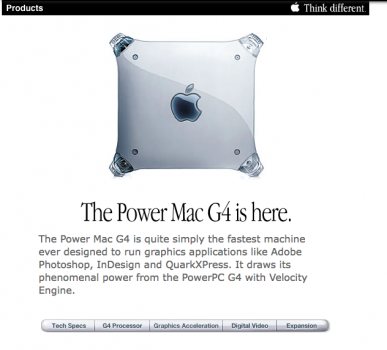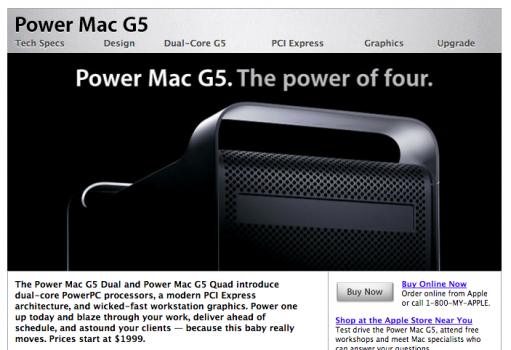When Jobs was re-hired by the company in 1997, Apple’s products — Mac and Newton both — had splayed across a mess of different naming conventions meant to describe the product’s specific features within the title itself. This often left the casual shopper at the mercy of someone who could break down the difference between, say, a Macintosh Performa 6260CD and a Macintosh Performa 6310CD. Or the PowerBook 1400, 2400, and 3400, along with all their variants. It was a long way from the time of Macintosh, Macintosh Plus, Macintosh IIx, and so on.
Jobs, as we know, radically simplified Apple’s offerings to the now-familiar “grid of four” product lines — with “pro” and “consumer” along one axis and “desktop” and “portable” along the other. Also, the processors weren’t marketed up front as “750” or “7400” as with the 601/603/604 predecessors, but instead as “G3”, “G4” and, later, “G5”.
This is how we ended up with, say, the Power Mac G5, the iMac G4, the PowerBook G3, and the iBook G4. There were variations within, but these were generally recognizable, even to the most casual consumer. They still are.
Later, Jobs tried a fifth product, the Cube. It flopped, but was later succeeded by the Mac mini. (This omits, of course, the Xserve, which didn’t see the light of day beyond data centre racks and was an unfamiliar name for people who mostly knew of the iBook, iMac, MacBook, and MacBook Air.)
Jobs’ switch to Intel went on to complete a long lasting “grid of six”, maintaining three desktop products and adding the MacBook Air to round out three portable Macs. Then we came to know “Core i3/i5/i7/i9” in Intel’s nomenclature to denote base processor capabilities — with a Core i9 Mac understood generally to be a higher end CPU than a Core i3 Mac. And so on.
Jobs’s “grid of six”, or “six pack”, despite the switch to Apple Silicon, stayed pretty consistent and legible for the last fourteen or so years — or the last 22 years, should one consider the G4 Cube to be the start of that “grid of six” era.
Until this week.
With the the addition of the Mac Studio, this grid is no longer. We’re up to seven discrete product lines (minding how the MacBook has been an on-again, off-again thing, and the iMac Pro basically being a beefy iMac) — coupled with processor names running the gamut of M1, M1 Pro, M1 Max, and now M1 Ultra (which, confusingly, is two M1 Maxes — “Maxs”? — combined). Further, we’re now seeing products with names like the “Apple MacBook Pro 16-inch M1 Pro,” which is suggestive of trying to use the product title as the vehicle for describing the nitty-gritty particulars, much as Apple did during the Gil Amelio years.
Or is it?
Anyhow, I wasn’t sure whether to post this on the PowerPC forum, but this seemed as good a place as any to start a conversation. [Mods: if you can think of a better place to house this discussion, feel free to move it there.]
The question I’m throwing out there for all you haggard users of Macs, especially those of us still daily-using our PowerPC Macs (ones generally from that period when processors were simply known as G3/G4/G5 and the products we use fit neatly inside that “Jobs grid”): do you find naming creep is now returned to Apple’s marque?
Discuss!
[End note: bear in mind this doesn’t factor in discussion of Apple’s other consumer products like the iPhone, iPad, and iPod Touch (which mostly makes my head ache just contemplating it).]
Jobs, as we know, radically simplified Apple’s offerings to the now-familiar “grid of four” product lines — with “pro” and “consumer” along one axis and “desktop” and “portable” along the other. Also, the processors weren’t marketed up front as “750” or “7400” as with the 601/603/604 predecessors, but instead as “G3”, “G4” and, later, “G5”.
This is how we ended up with, say, the Power Mac G5, the iMac G4, the PowerBook G3, and the iBook G4. There were variations within, but these were generally recognizable, even to the most casual consumer. They still are.
Later, Jobs tried a fifth product, the Cube. It flopped, but was later succeeded by the Mac mini. (This omits, of course, the Xserve, which didn’t see the light of day beyond data centre racks and was an unfamiliar name for people who mostly knew of the iBook, iMac, MacBook, and MacBook Air.)
Jobs’ switch to Intel went on to complete a long lasting “grid of six”, maintaining three desktop products and adding the MacBook Air to round out three portable Macs. Then we came to know “Core i3/i5/i7/i9” in Intel’s nomenclature to denote base processor capabilities — with a Core i9 Mac understood generally to be a higher end CPU than a Core i3 Mac. And so on.
Jobs’s “grid of six”, or “six pack”, despite the switch to Apple Silicon, stayed pretty consistent and legible for the last fourteen or so years — or the last 22 years, should one consider the G4 Cube to be the start of that “grid of six” era.
Until this week.
With the the addition of the Mac Studio, this grid is no longer. We’re up to seven discrete product lines (minding how the MacBook has been an on-again, off-again thing, and the iMac Pro basically being a beefy iMac) — coupled with processor names running the gamut of M1, M1 Pro, M1 Max, and now M1 Ultra (which, confusingly, is two M1 Maxes — “Maxs”? — combined). Further, we’re now seeing products with names like the “Apple MacBook Pro 16-inch M1 Pro,” which is suggestive of trying to use the product title as the vehicle for describing the nitty-gritty particulars, much as Apple did during the Gil Amelio years.
Or is it?
Anyhow, I wasn’t sure whether to post this on the PowerPC forum, but this seemed as good a place as any to start a conversation. [Mods: if you can think of a better place to house this discussion, feel free to move it there.]
The question I’m throwing out there for all you haggard users of Macs, especially those of us still daily-using our PowerPC Macs (ones generally from that period when processors were simply known as G3/G4/G5 and the products we use fit neatly inside that “Jobs grid”): do you find naming creep is now returned to Apple’s marque?
Discuss!
[End note: bear in mind this doesn’t factor in discussion of Apple’s other consumer products like the iPhone, iPad, and iPod Touch (which mostly makes my head ache just contemplating it).]
Last edited:




